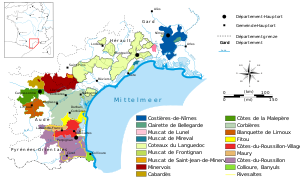Crémant de Limoux
The Crémant de Limoux is a medium-weight sparkling wine from the Languedoc wine-growing region with around 11–13% by volume . The sparkling wines of the region are characterized by their fruity character and are mainly blended from the Chardonnay and Chenin Blanc grape varieties , but also partly from the Mauzac and Pinot Noir varieties. The processed vines must come from the Languedoc in any case. Due to the use of classic bottle fermentation , which is similar to the production process for champagne , the wine is called crémant ; an indication of high quality. The term Crémant was introduced throughout France when the winegrowers in Champagne successfully enforced the ban on the worldwide common name Méthode Champenoise to characterize bottle fermentation. Compared to a winemaker's champagne, the Crémant de Limoux is slightly cheaper at around € 7–10 / bottle. The Crémant should be enjoyed at the latest 4 years after purchasing the bottle at a drinking temperature of 5 to 7 ° C.
Harvest quantities
Although similarly produced sparkling wine with the Blanquette de Limoux in Languedoc had existed for at least the 16th century, the AOC Crémant de Limoux was only introduced on August 21, 1990. After a tentative start until 1995, the amount pressed has increased continuously since then.
The basic yield, i.e. the harvest restriction, is a low 50 hectoliters / hectare; an amount that can be corrected up to 10% depending on the age group. A maximum of 100 liters of must can be pressed from 150 kg of grapes .
The berries for the Crémant are usually picked a few days before the harvest of normal still wines , as the base wines of a sparkling wine should have a strong acid structure. However, the minimum sugar content of the must for the base wine must be at least 153 g / l. (see also the article must weight )
Geography and climate
The appellation is located in the Aude department in the Occitanie region near the city of Limoux , in the west of the AOC Corbières . The southern slopes of the hills are reserved for the appellation and consist of a combination of lime-rich layered silicate and slightly pebbly soils.
Limoux's climate allows the production of white grape varieties. The area is influenced by the Mediterranean as well as the Atlantic Ocean, which ensure sufficient sunshine and well-distributed rainfall. In addition, the vineyards are located at a height of approx. 160 m, which means that day and night temperatures and a lower annual mean temperature are more clearly defined than in the nearby Narbonne .
history
Although the viticulture in Limoux has been documented in writing since 931, there are first mentions of a sparkling wine only from 1531. Monks of the Abbey of Saint-Hilaire were already masters of the production of Blanquette de Limoux.
Grape varieties
The Crémant de Limoux is made from three to four grape varieties :
- Chardonnay , with a minimum of 50% to max. 70% makes up the largest share
- Chenin Blanc , which with a minimum of 20% to max. 40% represents the second most important compulsory share
The sum of the two main varieties must not exceed 90 percent. There are also the minor varieties
- Mauzac and
- Pinot Noir approved: The sum of both parts must not exceed 20 percent.
For the Blanquette de Limoux produced in the same region according to the méthode dioise ancestrale (→ Blanquette méthode ancestrale ), only Mauzac is used. For the Blanquette brute (→ Blanquette de Limoux), the first three grape varieties mentioned with a share of 90% Mauzac.
Approved municipalities
Vineyards in a total of 42 municipalities were approved for the production of Crémant de Limoux. The region is congruent with the region of the Blanquette de Limoux: Alet , Ajac , Antugnac , Bouriège , Campagne-sur-Aude , Cassaignes , Castelreng , Cépie , Conilhac-de-la-Montagne , Couiza , Cournanel , Coustaussa , La Digne d'Amont , La Digne d'Aval , Espéraza , Fa , Festes-et-Saint-André , Gaja-et-Villedieu , Gardie , Ladern-sur-Lauquet , La Serpent , Limoux , Loupia , Luc-sur-Aude , Magrie , Malras , Montazels , Pauligne , Peyrolles , Pieusse , Pomas , Roquetaillade , Rouffiac-d'Aude , Saint-Couat-du-Razès , Saint-Hilaire , Saint-Polycarpe , Serres , Tourreilles , Vendémies , Villar-Saint-Anselme , Villebazy and Villelongue- d'Aude .
literature
- Jancis Robinson : The Oxford Wine Lexicon . Gräfe and Unzer Verlag, Munich 2003, ISBN 3-7742-0914-6 .
- Pierre Galet : Cépages et Vignobles de France . Lavoisier Publishing House, Paris 2004, ISBN 2-7430-0585-8 . (French language)
- Benoît France: Grand Atlas des Vignobles de France . Éditions SOLAR publishing house, Paris 2002, ISBN 2-263-03242-8 . (French language)

